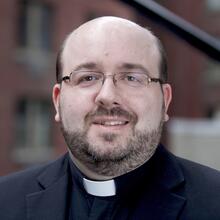“Here comes everybody.” The line is overused, of course, to describe the life of the church, but there are times when nothing else will do.
I landed in Rome four days after Pope Francis passed away, with just barely enough time to drop off my bag, restore myself to some semblance of wakefulness and take a bus over to the Vatican.
Then, as I have experienced so many times along the Via della Conciliazione, leading up from the Tiber to St. Peter’s Square, it was time to figure out how the lines would work. I have been lucky enough to be in Rome five times in the past few years, and every time the lines work a little differently. It reminded me of living in Boston through the Big Dig, when the highway interchanges were never the same from month to month.
This time, a kind woman in a yellow vest labelled “Protezione Civile”—a volunteer, I think—had pity on me and reassured me in English that I was in the right line to go and pray before Pope Francis’ body. Or at least, her face and tone were reassuring. What she actually said, gesturing at the throng of people with unexplained empty spaces between some of them, was “One line, two line, three line, it’s the same.” Here comes everybody.
The reassurance was solid. I waited for about three hours, and the line snaked back and forth across the square three times, but I got into the basilica to see Francis one last time and pray for him.
Over those three hours, I heard more languages than I could recognize. I had conversations with people from Buffalo and Ireland and Philadelphia and Belgium. I happened to pass my own archbishop, Cardinal Timothy Dolan, just after praying before Francis lying in the casket, and got to shake his hand. I prayed one of the Missal prayers “for a pope” with pilgrims who had come just for Francis; I met others who were here for the now-postponed canonization of Carlo Acutis that had been scheduled for the Second Sunday of Easter.
The mood in the line was convivial and almost joyful, filled with a sense of being together at this unique moment. We all realized, I think, that this is a story we will still be telling years from now.
Inside the basilica, people were more somber. And before the casket, the sense of prayer became palpable. There was a feeling of loss, certainly, and of grief. But it was not quite sadness, or at least not simply so. Pope Francis gave his life over to the mystery of God’s mercy, and now that giving had been completed. Thanks be to God for that.
The week in New York between Francis’ death and the flight to Rome had been so full of activity for me that I had little time to grieve for the Holy Father. The place I came closest was on Easter Monday, celebrating Mass in the America office and skipping over the place in the Eucharistic Prayer where Francis’ name would go—where his name had been spoken in every other Mass I had said since being ordained a priest in 2014.
Then I was sitting on a plane, about to take off for Rome, and a friend texted to ask how I was doing. I recounted that moment to her, and it hit in full force there, in quiet tears sitting on a taxiway.
Another friend, one of my Jesuit brothers, asked me to carry him with me in prayer as I paid my respects to Francis—to pray for him to have a heart like Francis’—pastoral, courageous and close to the people.
About a week later, I was in line again. This time, I was at the Basilica of St. Mary Major, across Rome from the Vatican, waiting to file past Francis’ tomb. The place to get into that line was easier to find, and it was only an hour long. But it had been about an hour long since Francis was laid to rest. After filing past his tomb and then finding a spot inside the church to pray for a while, I came outside and realized that the Salus Populi Romani, the icon of Mary that Francis visited so often, had been placed in front of the basilica so that people could pray before it and with Francis. Across the street, a banner hanging from the windows of a building read “Grazie, Francesco.” He was, again, close to the people.
The loss we are feeling, I think, is a measure of that closeness of Francis’ heart. In his last encyclical, “Dilexit Nos,” on the Sacred Heart, he wrote that Jesus “chose to love each of us with a human heart. His human emotions became the sacrament of that infinite and endless love” (No. 60).
In Francis’ heart, in his desire always to be close to the people to whom the Lord gave him as a shepherd, we see perhaps a sacrament of that sacrament: a glimpse of how the heart can cooperate more and more fully with the love of God. And so within the loss is a longing and hope.
Shape our hearts as you shaped Francis’ heart, Lord, so as to make our hearts more and more like yours.
This article has been updated for print publication.







